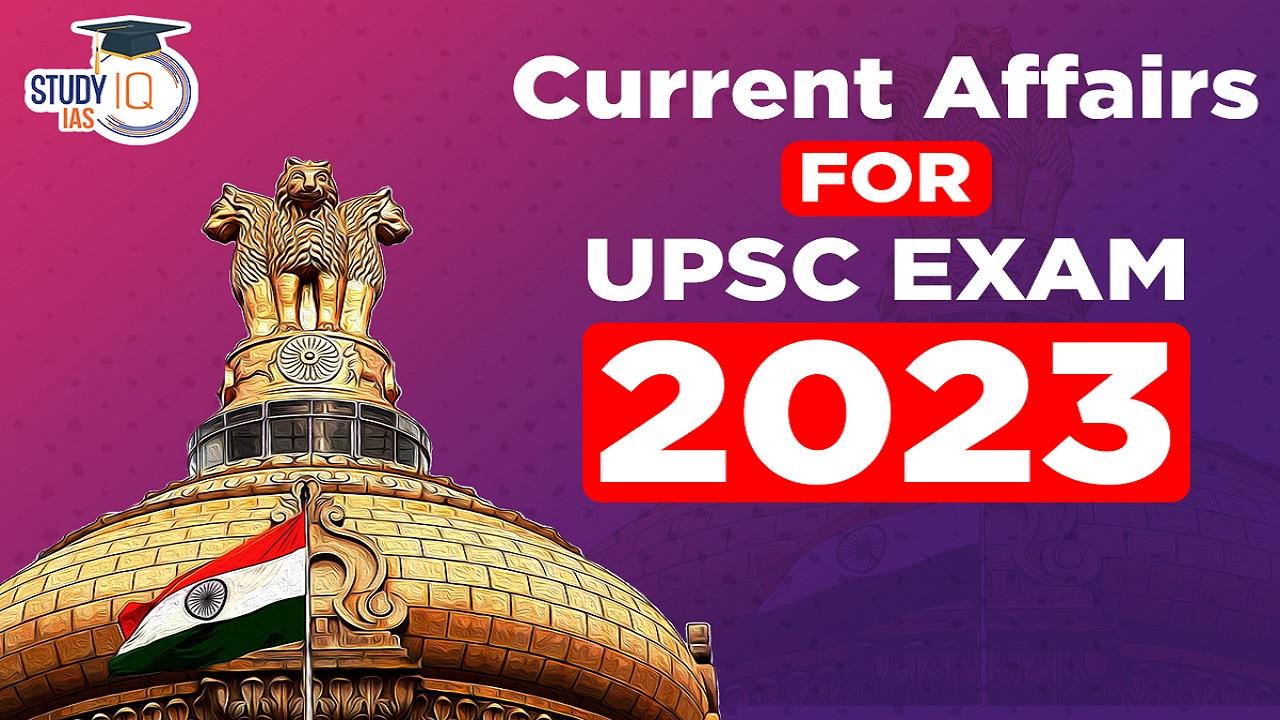Current Affairs 8th August 2023 for UPSC Prelims Exam
Havana Syndrome
Context: The Central government has told the Karnataka High Court that it will look into the matter of the ‘Havana Syndrome’ in India, in response to a Bengaluru resident’s recent petition.
About Havana Syndrome
- Definition: Havana Syndrome refers to a set of mental health symptoms that are said to be experienced by United States intelligence and embassy officials in various countries.
- In general, the word ‘syndrome’ simply means a set of symptoms.
- It does not mean a unique medical condition, but rather a set of symptoms that are usually experienced together whose origins may be difficult to confirm.
- Symptoms: Havana Syndrome typically involves symptoms such as hearing certain sounds without any outside noise, nausea, vertigo and headaches, memory loss and balance issues.
- Origin: Back in 2016, reports first emerged of US diplomats and other employees of the government falling ill in Havana, the capital of Cuba.
- The patients said they heard strange sounds and experienced odd physical sensations in their hotel rooms or homes, and had symptoms of nausea, severe headaches, fatigue, dizziness, sleep problems and hearing loss.
- This mysterious illness came to be called the “Havana Syndrome”.

- Causes:
- Initially during the Cuban experience, being in a country that had been hostile to the US for over five decades, the suspicion was on Cuban intelligence or a section within the Cuban establishment that did not want US-Cuba relations to normalise. It was then speculated to be a “sonic attack”.
- However, further study by scientists in the US and medical examination of the victims began to suggest that they may have been subjected to high-powered microwaves that either damaged or interfered with the nervous system.
- It was said to have built pressure inside the brain that generated the feeling of a sound being heard.
- Greater exposure to high-powered microwaves is said not only to interfere with the body’s sense of balance but also to impact memory and cause permanent brain damage.
- Low levels of microwaves are also emitted from mobile phones but they are not targeted.
- It was suspected that beams of high-powered microwaves were sent through a special gadget that Americans then called a “microwave weapon”.
- The use of microwaves as a counter-intelligence tactic has been experimented with since the Cold War and both Russia and the US have made attempts to weaponize it. There have been reports of US embassy officials in Moscow experiencing mental health issues due to the suspected use of microwaves in the 1970s.
- Latest Investigation by US: After many years of data collection, experiments and medical examination of victims, the US has as yet not been able to come up with any conclusive evidence suggesting the “microwave weapon” is a reality.
- Havana Syndrome in India:
- As of July 2023, the 2021 incident was the only reported occurrence of the syndrome in India.
- Sources in the Indian security establishment said in 2021 that they were not aware of any weapon with such capacities being in the possession of an Indian agency.
- Even if there was one, it was unlikely the government would admit to having acquired such counter-espionage technology given the sensitive nature of intelligence work.
Current Affairs 7th August 2023 for UPSC Prelims Exam
Economic Community of West African States (ECOWAS)
Context: The West African regional organization ECOWAS announced that its leaders are scheduled to convene to address the situation in Niger.
About Economic Community of West African States (ECOWAS)
- Definition: It is a regional political and economic union of fifteen countries located in West Africa.
- Established in 1975, with the signing of the Treaty of Lagos.
- Aim: The goal of ECOWAS is to achieve “collective self-sufficiency” for its member states by creating a single large trade bloc by building a full economic and trading union.
- It also serves as a peacekeeping force in the region.
- Vision: Creation of a borderless region where the population has access to its abundant resources and is able to exploit same through the creation of opportunities under a sustainable environment.
- It is considered one of the pillar regional blocs of the continent-wide African Economic Community (AEC).
- ECOWAS includes two sub-regional blocs:
- The West African Economic and Monetary Union is an organisation of eight, mainly French-speaking states.
- The West African Monetary Zone (WAMZ), established in 2000, comprises six mainly English-speaking countries.
- ECOWAS Summit 2023: The Summit will be held in Abuja, on August 10, 2023.

Emblems and Names Act
Context: Delhi High Court has sought responses from the Centre, the Election Commission of India (ECI), and an alliance of 26 opposition parties in a public interest litigation (PIL) against these parties’ use of the acronym I.N.D.I.A. (Indian National Developmental Inclusive Alliance).
- The PIL has contended that the use of the acronym violates provisions of The Emblems and Names (Prevention of Improper Use) Act, 1950.
More on News
- The PIL has been filed by social worker against the formation of an “alliance using the name INDIA”.
- The plea seeks directions to the parties prohibiting them from using the acronym, and a direction to the Centre and ECI to take action against them.
About The Emblems and Names (Prevention of Improper Use) Act, 1950
- Definition: The Act was passed on March 1, 1950, to “prevent the improper use of certain emblems and names for professional and commercial purposes”.
- It extends to the whole of India and also applies to citizens of India outside India.
- Terms:
- Emblem: Any emblem, seal, flag, insignia, coat-of-arms, or pictorial representation specified in the Schedule;
- Competent Authority: Any authority competent under any law for the time being in force to register any company, firm, or other body of persons or any trademark or design or to grant a patent;
- Name: Includes any abbreviation of a name.
- Prohibition of Improper Use (Section 3): Regardless of any existing laws, individuals are not allowed to use or keep using, without prior permission from the Central Government or its authorized officer, any name or emblem listed in the Schedule or any imitation of it that looks similar.
- This applies to using them for trade, business, profession, patent titles, trademarks, or designs. The Central Government may specify certain cases and conditions where such usage is allowed.
- Specifications in Schedule: It prohibits the improper usage of the name, emblem, or official seal of the Government of India (GOI) or of any state, the World Health Organisation (WHO), or the United Nations Organisation (UNO).
- It also bars such usage of the national flag, the Prime Minister, the President, and the Governor’s seal, name, and emblem. Besides this, using names, emblems, or seals of historical figures like Mahatma Gandhi, Jawaharlal Nehru, Lal Bahadur Shastri, and Indira Gandhi is also prohibited.
- Penalty: Any person who contravenes the provisions of section 3 shall be punishable with a fine which may extend to 500 rupees.
- Power to Centre:
- If any question arises before such an authority as to whether any emblem falls under the ones specified in the Schedule, the authority may refer the question to the Centre, following which the latter’s decision will be final.
- The Central Government may, by notification in the Gazette, add to or alter the Schedule, and any such addition or alternation shall have effect as if it had been made by this Act.
- The government also has the power to make rules to fulfil the objectives of this Act, which will be published in the Official Gazette.
- Every such rule will be laid before both Houses of Parliament for thirty days while in session, following which, if a modification or cancellation of the same is suggested, the rule will have effect only in such modified form or no effect at all.
Amrit Bharat Stations Scheme
Context: The Prime Minister has laid the foundation stone for the redevelopment of 508 railway stations across the country virtually as part of Amrit Bharat Stations scheme.
About Amrit Bharat Stations Scheme
- Aim: It envisages development of stations on a continuous basis with a long-term vision.
- Need:
- India Railways is an integral part of the nation’s transportation infrastructure.
- In a bid to keep it safe for passengers as well as freight transportation, it is essential to modernise its infrastructure with latest technologies, amenities and others from time to time.
- In this context, the government is working to transform the railway stations across the country in line with its vision of ‘Naya Bharat’/ New India.
- Features:
- The scheme will subsume all previous redevelopment projects where work is yet to begin.
- The scheme aims at preparation of Master Plans of the Railway stations and implementation of the Master Plan in phases to enhance the facilities including and beyond the Minimum Essential Amenities.
- However, plans and consequent budgets will only be approved on the basis of factors such as footfall and inputs from stakeholders.
- Zonal railways have been given the responsibility of selecting stations, which will then be approved by a committee of senior railway officials.
- The model envisages low-cost redevelopment of stations which can be executed timely.
- The scheme shall cater for introduction of new amenities as well as upgradation and replacement of existing amenities.
- Facilities Planned under the Scheme:
- Provision for Roof Plaza to be created in future.
- Free Wi-Fi, space for 5G mobile towers.
- Smooth access by widening of roads, removal of unwanted structures, properly designed signages, dedicated pedestrian pathways, well planned parking areas, improved lighting etc.
- Attempts shall be made to club different grades/types of waiting halls and provide good cafeteria/retail facilities as far as possible.
- Better furniture will be installed in waiting rooms, platforms, rest rooms and offices.
- High level platforms(760-840 mill meter) shall be provided at all categories of stations.
- Special amenities for the disabled as per guidelines issued by the Railway Board from time to time.
- Redevelopment of 508 Railway Stations:
- The chosen 508 stations are spread across 27 states and union territories, including 55 each in Uttar Pradesh and Rajasthan, 49 in Bihar, 44 in Maharashtra, 37 in West Bengal, 34 in Madhya Pradesh, 32 in Assam, 25 in Odisha, 22 in Punjab, 21 each in Gujarat and Telangana, 20 in Jharkhand, 18 each in Andhra Pradesh and Tamil Nadu, 15 in Haryana, and 13 in Karnataka among others.
- 55 Amrit Stations will be developed at the cost of ₹4,000 crores in Uttar Pradesh and Rajasthan, 34 stations in Madhya Pradesh at the cost of ₹1,000 crores, 44 stations in Maharashtra at ₹1,500 crores, and prime railway stations in Tamil Nadu, Karnataka and Kerala among others will be redeveloped.
- Master Plans were being prepared for the development of these stations as ‘City Centres’, with proper integration of both sides of the city.
- This integrated approach is driven by the holistic vision of the overall urban development of the city, centred around the railway station.
- These stations will have better seating on platforms, upgraded waiting rooms and free Wi-Fi amongst other things.
- The redevelopment will provide modern passenger amenities along with ensuring well-designed traffic circulation, inter-modal integration, and signage for the guidance of passengers. The design of the station buildings will be inspired by local culture, heritage, and architecture.
- Jaipur Railway Stations will have glimpses of Hawa Mahal and Amer Fort from Rajasthan, Jammu Tawi Railway Station will be inspired by the famous Raghunath Mandir and Dimapur Station of Nagaland will showcase the local architecture of 16 different tribes from the region.
- The government aims to produce green energy from every railway station soon.
- LED lights have been installed in about 70,000 coaches and the number of bio-toilets in trains has increased 28 times as compared to 2014.
- The Amrit stations will be built to meet the standards of green buildings. By 2030, India will be a country whose railway network will run on net zero emissions.


 SSC Stenographer 2024 Notification Out a...
SSC Stenographer 2024 Notification Out a...
 IB SA MTS Final Result 2024 Out at mha.g...
IB SA MTS Final Result 2024 Out at mha.g...
 Model Skill Loan Scheme, Eligibility, Re...
Model Skill Loan Scheme, Eligibility, Re...

















